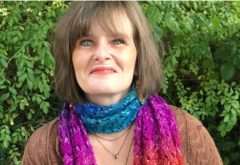My name is Joey (Jo) Lea Baird and I am a Scoliosis Survivor. When people ask me what’s wrong with my back and I tell them I have Scoliosis, they have no idea what Scoliosis is or the effects it can have on a person. So I would like to supply you with some of the basics of what Scoliosis is; some of the signs you can look for in others; and if you have Scoliosis some of the things you can do to become a Survivor as well.
Here is the Mayo Clinic’s definition of Scoliosis:
“Scoliosis is a sideways curvature of the spine that occurs most often during the growth spurt just before puberty. While scoliosis can be caused by conditions such as cerebral palsy and muscular dystrophy, the cause of most scoliosis is unknown.”
Most cases of scoliosis are mild, but some children develop spine deformities that continue to get more severe as they grow. Severe scoliosis can be disabling. An especially severe spinal curve can reduce the amount of space within the chest, making it difficult for the lungs to function properly.
Children who have mild scoliosis are monitored closely, usually with X-rays, to see if the curve is getting worse. In many cases, no treatment is necessary. Some children will need to wear a brace to stop the curve from worsening. Others may need surgery to keep the scoliosis from worsening and to straighten severe cases of scoliosis.
Signs and symptoms of scoliosis may include:
- Uneven shoulders
- One shoulder blade that appears more prominent than the other
- Uneven waist
- One hip higher than the other
If a scoliosis curve gets worse, the spine will also rotate or twist, in addition to curving side to side. This causes the ribs on one side of the body to stick out farther than on the other side.
Causes
Doctors don’t know what causes the most common type of scoliosis — although it appears to involve hereditary factors, because the disorder tends to run in families. Less common types of scoliosis may be caused by:
- Neuromuscular conditions, such as cerebral palsy or muscular dystrophy
- Birth defects affecting the development of the bones of the spine
- Injuries to or infections of the spine
Risk factors for developing the most common type of scoliosis include:
- Age. Signs and symptoms typically begin during the growth spurt that occurs just prior to puberty.
- Sex. Although both boys and girls develop mild scoliosis at about the same rate, girls have a much higher risk of the curve worsening and requiring treatment.
- Family history. Scoliosis can run in families, but most children with scoliosis don’t have a family history of the disease.
Complications
While most people with scoliosis have a mild form of the disorder, scoliosis may sometimes cause complications, including:
- Lung and heart damage. In severe scoliosis, the rib cage may press against the lungs and heart, making it more difficult to breathe and harder for the heart to pump.
- Back problems. Adults who had scoliosis as children are more likely to have chronic back pain than are people in the general population.
- Appearance. As scoliosis worsens, it can cause more noticeable changes — including unlevel shoulders, prominent ribs, uneven hips, and a shift of the waist and trunk to the side. Individuals with scoliosis often become self-conscious about their appearance
- .https://www.mayoclinic.org/diseases-conditions/scoliosis/symptoms-causes/syc-20350716
Again here are some links that will take you to sites that have more in depth information on Scoliosis.
https://www.mayoclinic.org/diseases-conditions/scoliosis/symptoms-causes/syc-20350716
https://en.wikipedia.org/wiki/Scoliosis
https://www.spineuniverse.com/
What Is Scoliosis and What Should I Be Looking For In My Children






[sc name=”Affiliate Disclaimer”]

